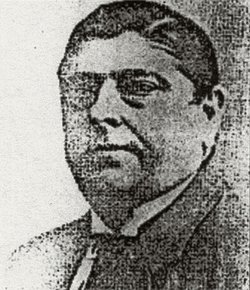Alessandro Moreschi
|
|
Alessandro Moreschi (November 11, 1858 - April 21, 1922) was one of the most famous castrati singers of the late 19th century, and was the only castrato of the classic bel canto tradition to make sound recordings.
He was perhaps the best known castrato of his day after Domenico Mustafa, a former "Direttore Perpetuo" of the Sistine Chapel. Other famous castrati singers at this time were Domenico Salvatori and Giovanni Cesari.
Alessandro Moreschi was born to a large family in the town of Montecompatrio. It was suggested that he was castrated around 1865, but it is uncertain what were the exact reasons for performing the procedure -- whether it was due to purely medical (such as scrotal hernia), or musical reasons.
Nevertheless, being now a castrato, he was appointed to the music school of Scuola di San Salvatore in Lauro, where he was discovered by Gaetano Capocci, who became his teacher. In 1873 he was nominated as a primary soprano at the Chapel of Laterano. In 1883 he was invited to join, and later same year admitted to the Capella Sistina, after being heard performing the role of Seraph in the oratorio Christus am Ölberge by Beethoven. At that time Moreschi's voice was a high soprano of extraordinary purity and agility, to such an extent that he was nicknamed "Angelo di Roma" and made soloist of the Capella Sistina by the pope.
In 1891 he was made a secretary of the Chapel. In 1898 Moreschi was promoted to the director of the choir, and two years later appeared singing in the funeral of Italian king Umberto I at the Pantheon.
In the spring of 1902 Moreschi made the first of his phonograph recordings, singing on gramophone records for the Gramophone & Typewriter Company. He made additional recordings in 1904. In all he made 17 recordings, where 8 of these were solo. Moreschi was, apart from being a soloist and director of the chorus, also a singing teacher, mostly of young falsettists.
By March 1913 he retired from the Cappella Sistina to his home in Rome where he spent the rest of his life. He still performed under certain circumstances, such as under a mass celebration at the Capella Giulia in 1914. He was also a friend of a German writer Franz Habock, author of the extremely important "Die Kastraten und ihre Gesangskunst", who planned to cast Moreschi in reviving the Farinelli repertoire in 1914. However, the grand plan failed to became a reality due to several obstacles on the way - the war and the decay of Moreschi's voice has been suggested, yet Habock himself point out the main reason for the failure: Moreschi, as all the other Capella singers, was simply unqualified to sing the Baroque repertoire in a proper way.
Regarding Moreschi's appearance Habock had this to say, after seeing him in 1914:
- Moreschi was of average height and rather short in stature; he had no facial hairs and his chest was broad and overdeveloped. In his youth, when he sang the Seraph`s oratorio at the age of 25, his vocal range was from C` to E```. Now however, at the end of his career, his range is only from A to G``. Moreschi's speaking voice have a certain silverine quality to it, and reminds much of a high tenor. However, both his appearance and voice gives an impression of him still being a young person. (Moreschi was 56 years old at this time.)
In the spring of 1922 Moreschi caught pneumonia and died shortly afterwards at his home in Rome.
1904 Recording of Ave Maria (http://www.archive.org/audio/audio-details-db.php?collection=78rpm&collectionid=AlessandroMoreschi)de:Alessandro Moreschi ja:アレッサンドロ・モレスキ

